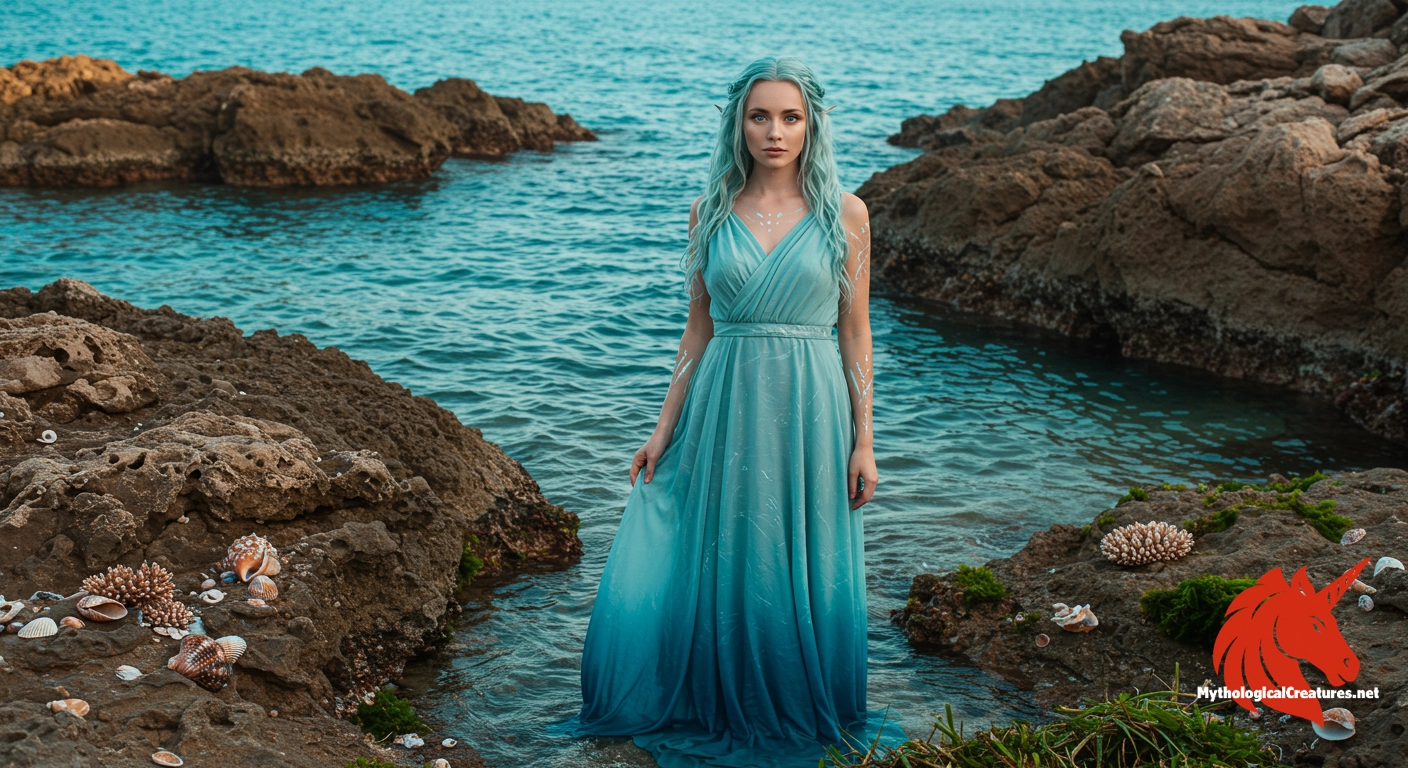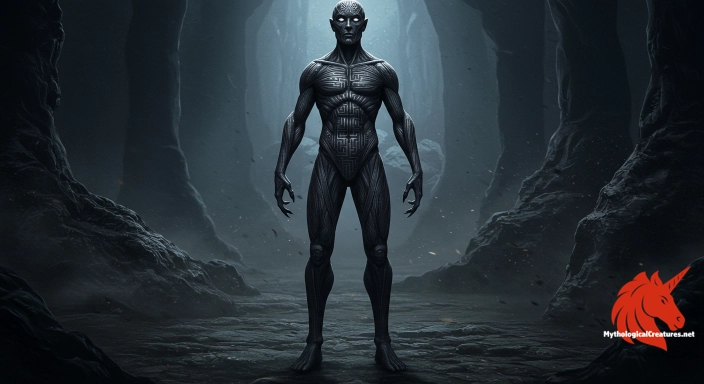Nereids: The Nereids are sea nymphs in Greek mythology, known as the 50 beautiful daughters of Nereus and Doris.

Nereids
Nereids - Symbolise the nurturing and mysterious aspects of the sea and its influence on seafaring.
Origins & First Encounters
The Nereids emerge from Greek myth as enchanting sea nymphs whose origins are steeped in the mystery of the ocean. Born as the fifty daughters of Nereus, the ‘Old Man of the Sea’, and his consort Doris, they have long been celebrated as the personifications of the sea’s splendour and caprice. Their earliest presence is evident in the works of ancient poets like Homer and Hesiod, where their roles as aides to Poseidon helped establish their celestial resonance. They embody both the serene beauty and the tempestuous unpredictability of the marine world, mirroring the dual nature of the ocean itself. Revered in the coastal communities of ancient Greece, their depictions reveal a blend of divine grace and natural vitality. They have been portrayed as events of comfort to mariners, nurturing as well as guiding souls caught in the restless tides. Their tales weave together the human longing for safety and the awe experienced in the face of nature’s grandeur. Over time, the Nereids have maintained an enduring presence in myth, symbolising the eternal allure and mystique of the sea.
Source Texts & Tale Variants
The lore of the Nereids is richly documented in a variety of ancient texts and oral traditions that span several centuries. Early literary works such as Hesiod’s Theogony and Homer’s epic narratives introduce these sea nymphs with a blend of reverence and narrative whimsy. Their appearances in the mythic exploits of the Argonauts underscore their reputation as benevolent guides for those who venture into the vast, uncertain waters. Many classical sources delicately balance their roles between divine personifications and tangible protectors of seafarers. In addition to poetic texts, representations on ancient pottery, sculptures, and mosaics have provided visual evidence of their integral place in Hellenic culture. These artistic interpretations often capture a sense of fluidity and movement, reflective of the very essence they represent. Later Roman adaptations enriched their narrative, merging the Nereids with local water deities and reinterpreting their myths to suit broader Mediterranean tastes. The variety of accounts available underlines the adaptability of their myth, as regional storytellers embraced the nurturing yet unpredictable aspects of the sea through the image of these luminous nymphs.
Form & Powers
The Nereids have been depicted as exquisitely beautiful beings who seem to be fashioned from the very essence of the sea. Their features are rendered with an ethereal quality; slender, graceful, and imbued with a luminous radiance that mirrors the shifting colours of ocean water. Flowing hair, often depicted with hints of seafoam and silver light, cascades over delicate shoulders in unrestrained natural elegance. Their eyes are said to reflect the deep azure of the boundless sea, carrying both wisdom and a playful sparkle. Artists have frequently adorned them with natural embellishments such as garlands of seaweed, strands of pearls, and other marine motifs that accentuate their intrinsic connection to underwater realms. Varying slightly among different depictions, each Nereid appears as an individual manifestation of the sea’s varied beauty, ranging from demure and soft to vibrantly spirited. The interplay of light on their skin conjures images of sun-dappled waters at dawn, reinforcing their role as custodians of the gentle and tumultuous aspects of nature. Their appearance, whether rendered in sculpture or painting, consistently invites viewers to ponder the alluring mystique and fluid power of the ocean.
Regional Faces
Although the essence of the Nereids is firmly rooted in classical Greek mythology, their portrayal has experienced intriguing regional adaptations. In various coastal areas of ancient Greece, these sea nymphs were interwoven with local maritime traditions, often revered as guardians who ensured the safety of fishermen and navigators. The fluid image of these nymphs allowed them to merge with indigenous water spirit legends, resulting in slight adjustments of appearance and character to resonate with local sensibilities. In the Aegean and Ionian regions, artistic interpretations sometimes emphasised more robust or dramatic features, reflecting the unique regional relationship with the unpredictable sea. Among the Romans, the Nereids’ narrative was often conflated with local aquatic deities, creating a hybrid mythos that celebrated both the universal and particular aspects of the sea’s might. Coastal communities even developed rituals that invoked their protective blessings, underscoring the enduring importance of these figures in local folklore. Subtle variations in attire, gesture, and iconography within regional artworks reveal a dynamic dialogue between the standard myth and local cultural expressions. Such regional diversity illustrates how the underlying symbolism of the Nereids was adapted to meet the distinct emotional and spiritual needs of different communities across the Mediterranean basin.
Cultural Parallels
The myth of the Nereids offers a captivating point of comparison with other aquatic entities found across world mythologies. In many respects, they share attributes with the naiads, who similarly embody the spirit of freshwater, yet the Nereids are unique in their dominion over the boundless and often unpredictable sea. Like the sirens of later myths, they capture the human imagination with their compelling beauty, though unlike the sirens they are celebrated for their nurturing and protective qualities rather than perilous seduction. This interplay of benevolence and mystique echoes in other cultural traditions, such as the Celtic water fairies whose appearances similarly blend charm with cautionary tales of nature. Their representation also invites parallels with the mermaids of later European lore, where the inherent duality of water as a source of life and a harbinger of danger is a recurrent theme. In many non-Western mythologies, analogous water spirits reflect a universal respect for the unpredictable and transformative character of aquatic environments. These comparative narratives illuminate the broader human fascination with water deities as multifaceted symbols of nature's bounty and ferocity. Consequently, the Nereids continue to serve as a bridge between disparate cultural interpretations of water, reinforcing a cross-cultural dialogue on the themes of beauty, protection, and the inexorable power of the sea.
Legacy & Modern Evolution
Throughout the centuries, the portrayal of the Nereids has evolved from classical representations on ancient vases and temples to nuanced interpretations in modern art and literature. They have transitioned from mere figures of myth into enduring symbols of the sea’s beauty, mystery, and mercurial temperament. The Renaissance period witnessed a revival of interest in classical themes, with artists rediscovering the elegant forms of the Nereids and imbuing them with a sense of romanticism and wistful allure. In more recent times, their image has been interwoven into fantasy literature, film, and popular art, symbolising the eternal allure of the ocean and its seductive yet unpredictable nature. Modern depictions often emphasise themes of environmental awareness, casting the Nereids as protectors of marine ecosystems amidst contemporary ecological challenges. Digital art and multimedia projects have further reimagined these ancient figures, blending traditional iconography with contemporary aesthetics. Their continued presence in modern culture reinforces the idea that ancient myth can evolve and resonate with new generations. As symbols of transformation, resilience, and natural beauty, the legacy of the Nereids persists as a testament to the enduring power of myth in navigating the complexities of both nature and human imagination.
Interesting Fact
Despite not being as prominently featured as major deities, the Nereids have profoundly influenced artistic depictions of the sea and continue to be celebrated as symbols of maritime benevolence.
Quick Creature Info
Origin:
Features:
Associations:
Our Mythic Legendary Rating:

Also Sometimes Known As:
Habitat:
Supernatural Powers:
Physical Attributes:
Abilities:
Behavior:
Lore:
Related Creatures, Tales or Lore
- NNaiads
- OOceanids
- HHamadryads
References
Discover Another Mythical Legend You May Not Have Heard Of?
Uncover the mysteries of ancient folklore and expand your knowledge of legendary beings from cultures around the world.
Dare to Meet the Sathariel....
Mythical Disclaimer: The images and data on this site are derived from various historical and literary sources, but we have found that many myths often have multiple versions and interpretations across references, sometimes contradictory. As a result, these creature depictions are artistic interpretations—imaginative blends of folklore, legend, and a dash of AI guesswork. Because creature descriptions vary widely, our illustrations and accompanying information represent our best effort to honor mythology while bridging creative gaps. Enjoy these interpretations—just remember, we've done our best to respect the stories and validate available data, but in the realm of mythology, details often shift, imagination leads the way, and nothing is ever set in stone!
Curated by the Mythological Creatures Team (rev. May 2025)
